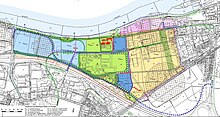Salina Raurica
Salina Raurica is the name given to the area in the Rhine valley between the industrial area Schweizerhalle and the Swiss municipalities of Pratteln , Augst (Canton Baselland) and Kaiseraugst (Canton Aargau). Salina Raurica is the largest contiguous working area in the canton of Baselland.
location
The Salina Raurica area comprises a total of approx. 60 hectares of building land and is located in the canton of Baselland on the Rhine plain between the industrial area Schweizerhalle in the west and the Roman town of Augusta Raurica in the east. In the north the area is bounded by the Rhine, in the south the A3 national road and the railway line separate the area from the community centers.
history
Salt has been extracted in Salina Raurica, Switzerland's first Rhine saline , since 1837 . Therefore, due to the high industrial demand for sodium chloride, the cluster for the manufacture of chemical and pharmaceutical products was created here. The excellent traffic situation for all modes of transport (air, water, road, rail) and the proximity to established locations of the chemical and pharmaceutical industry (Kaiseraugst, Schweizerhalle, Auhafen and Basel-Stadt ) meant that the area was included in the cantonal structure plan as a working area of cantonal importance was added. In order to make the areas in the Salina Raurica usable on the one hand and to take into account the interests of all stakeholders , including residents, investors, landowners, and nature conservation, on the one hand, the area is being developed in a multi-stage planning process under the leadership of the Basel-Landschaft Spatial Planning Office.
In 1998, the District Administrator of the Canton of Baselland designated the Rhine plain between Pratteln and Augst as a work area of cantonal importance and instructed the government to resolve conflicts between commercial use and amphibian protection (the protected natterjack toad had settled in a disused gravel pit), problems with road and Solve railway noise and plan suitable zones and connections. Therefore, the Salina Raurica special structure plan was subsequently drawn up and approved by the district administrator in 2009 with the following objectives:
- Salina Raurica is being developed into a business location.
- The sub-areas are assigned to rough usage categories (commercial, industrial uses west of the wastewater treatment plant (ARA), mixed residential and business areas around the Salina Raurica train station and the Längi-Park as well as residential areas on the Rhine).
- The existing cantonal road will be relocated and the route for the tram corridor will be secured.
On the basis of the special plan, the municipalities adopted their new land use plans by the end of 2016 in accordance with the principles of Swiss spatial planning.
In January 2009, the District Administrator and the Federal Council approved the Salina Raurica special structure plan, including the associated financial submission. In 2012, the establishment of the new Coop production facility LoBOS began to the east of Salinenstrasse. In 2013, the EBL (Elektra Baselland Cooperative) built a transformation plant east of the Coop production. In 2014, EBL started building a block-type thermal power station, signing the letter of intent between the canton and Losinger Marazzi AG regarding developments in the east. In 2017, the Pratteln Zurlinden bus stop went into operation.

